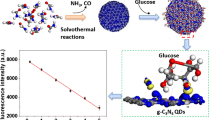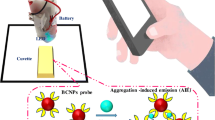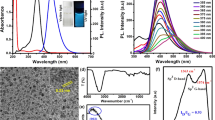Abstract
A hybrid nanomaterial was synthesized that consists of poly(5-indolylboronic acid) acting as a molecular imprint (MIP), and of fluorescent carbon dots (CDs). The combination of CDs and MIP endowed the hybrid with stable fluorescence and template selectivity. The addition of glucose causes aggregation and quenching of fluorescence. Aggregation is due to the formation of covalent bonds between the cis-diols of glucose molecules and boronic acid side groups. The fluorometric signal, obtained at excitation/emission wavelengths of 350/450 nm, varies in the 5 to 750 μM glucose concentration range, with a 0.5 μM detection limit. The assay is not interfered by various biomolecules including fructose and was successful applied to the determination of glucose in (spiked) serum. In our perception, the results make this glucose assay an attractive new tool for clinical applications.

Schematic presentation of a hybrid nanomaterial that consists of poly(5-indolylboronic acid) acting as a molecular imprint, and of carbon dots. The addition of glucose causes fluorescence quenching in the range of 5–750 μM with a 0.5 μM detection limit.







Similar content being viewed by others
References
Zhang ZY, Chen ZP, Cheng FB, Zhang YW, Chen LX (2017) Highly sensitive on-site detection of glucose in human urine with naked eye based on enzymatic-like reaction mediated etching of gold nanorods. Biosens Bioelectron 89:932–936
Steiner MS, Duerkop A, Wolfbeis OS (2011) Optical methods for sensing glucose. Chem Soc Rev 40:4805–4839
Arakawa T, Kuroki Y, Nitta H, Chouhan P, Toma K, Sawada S, Takeuchi S, Sekita T, Akiyoshi K, Minakuchi S, Mitsubayashi K (2015) Mouthguard biosensor with telemetry system for monitoring of saliva glucose: a novel cavitas sensor. Biosens Bioelectron 84:106–111
Hoa LT, Chung JS, Hur SH (2016) A highly sensitive enzyme-free glucose sensor based on Co3O4 nanoflowers and 3D graphene oxide hydrogel fabricated via hydrothermal synthesis. Sens Actuators B Chem 223:76–82
Lin LP, Song XH, Chen YY, Rong MC, Zhao TT, Wang YR, Jiang YQ, Chen X (2015) Intrinsic peroxidase-like catalytic activity of nitrogen-doped graphene quantum dots and their application in the colorimetric detection of H2O2 and glucose. Anal Chim Acta 869:89–95
Chen S, Hai X, Chen XW, Wang JH (2014) In situ growth of silver nanoparticles on graphene quantum dots for ultrasensitive colorimetric detection of H2O2 and glucose. Anal Chem 86:6689–6694
Hao TF, Wei X, Nie YJ, Xu YQ, Lu K, Yan YS, Zhou ZP (2016) Surface modification and ratiometric fluorescence dual function enhancement for visual and fluorescent detection of glucose based on dual-emission quantum dots hybrid. Sens Actuators B Chem 230:70–76
Liu XJ, Yang WX, Chen LL, Jia JB (2016) Synthesis of copper nanorods for non-enzymatic amperometric sensing of glucose. Microchim Acta 183:2369–2375
Yuan J, Cen Y, Kong XJ, Wu S, Liu CLW, Yu RQ, Chu X (2015) MnO2-nanosheet-modified upconversion nanosystem for sensitive turn-on fluorescence detection of H2O2 and glucose in blood. ACS Appl Mater Interfaces 7:10548–10555
Wang H, Yi JH, Velado D, Yu YY, Zhou SQ (2015) Immobilization of carbon dots in molecularly imprinted microgels for optical sensing of glucose at physiological pH. ACS Appl Mater Interfaces 7:15735–15745
Bradley SJ, Kroon K, Laufersky G, Röding M, Goreham RV, Gschneidtner T, Schroeder K, Moth-Poulsen K, Andersson M, Nann T (2017) Heterogeneity in the fluorescence of graphene and graphene oxide quantum dots. Microchim Acta 184:871–878
Zhang FW, Wen QJ, Hong MZ, Zhuang ZY, Yu Y (2017) Efficient and sustainable metal-free GR/C3N4/CDots ternary heterostructrues for versatile visible-light-driven photoredox applications: towards synergistic interaction of carbon materials. Chem Eng J 307:593–603
Arcudi F, Dordevic L, Prato M (2016) Synthesis, separation, and characterization of small and highly fluorescent nitrogen-doped carbon nanodots. Angew Chem Int Ed 55:2107–2112
Li Y, Zhao Y, Cheng HH, Hu Y, Shi GQ, Dai LM, Qu LT (2011) Nitrogen-doped graphene quantum dots with oxygen-rich functional groups. J Am Chem Soc 134:15–18
Niu MC, Pham-Huy C, He H (2016) Core-shell nanoparticles coated with molecularly imprinted polymers: a review. Microchim Acta 183:2677–2695
Dai H, Xiao DL, He H, Li H, Yuan DH, Zhang C (2015) Synthesis and analytical applications of molecularly imprinted polymers on the surface of carbon nanotubes: a review. Microchim Acta 182:893–908
Zhou X, Wang AQ, Yu CF, Wu SS, Shen J (2015) Facile synthesis of molecularly imprinted graphene quantum dots for the determination of dopamine with affinity-adjustable. ACS Appl Mater Interfaces 7:11741–11747
Wu WT, Shen J, Li YX, Zhu HB, Banerjee P, Zhou SQ (2012) Specific glucose-to-SPR signal transduction at physiological pH by molecularly imprinted responsive hybrid microgels. Biomaterials 33:7115–7125
Zhou X, Ma PP, Wang AQ, Yu CF, Qian T, Wu SS, Shen J (2015) Dopamine fluorescent sensors based on polypyrrole/graphene quantum dots core/shell hybrids. Biosens Bioelectron 64:404–410
Pringsheim BE, Terpetschnig E, Piletsky SA, Wolfbeis OS (1999) A polyaniline with near-infrared optical response to saccharides. Adv Mater 10:865–868
Shen PF, Xia YS (2014) Synthesis-modification integration: one-step fabrication of boronic acid functionalized carbon dots for fluorescent blood sugar sensing. Anal Chem 86:5323–5329
Na WD, Liu H, Wang MY, Su XG (2017) A boronic acid based glucose assay based on the suppression of the inner filter effect of gold nanoparticles on the orange fluorescence of graphene oxide quantum dots. Microchim Acta 184:1463–1470
Mader HS, Wolfbeis OS (2008) Boronic acid based probes for microdetermination of saccharides and glycosylated biomolecules. Microchim Acta 162:1–34
Pan D, Zhang J, Li Z, Wu M (2010) Hydrothermal route for cutting graphene sheets into blue-luminescent graphene quantum dots. Adv Mater 22:734–738
Qu ZB, Zhou XG, Gu L, Lan RM, Sun DD, Yu DJ, Shi GY (2013) Boronic acid functionalized graphene quantum dots as a fluorescent probe for selective and sensitive glucose determination in microdialysate. Chem Commun 49:9830–9832
Zhang L, Zhang ZY, Liang RP, Li YH, Qiu JD (2014) Boron-doped graphene quantum dots for selective glucose sensing based on the “abnormal” aggregation-induced photoluminescence enhancement. Anal Chem 86:4423–4430
Fuyuno N, Kozawa D, Miyauchi Y, Mouri S, Kitaura R, Shinohara H, Yasuda T, Komatsu N, Matsuda K (2014) Drastic change in photoluminescence properties of graphene quantum dots by chromatographic separation. Adv Opt Mater 2:983–989
Wu WT, Zhou T, Berliner A, Banerjee P, Zhou SQ (2010) Glucose-mediated assembly of phenylboronic acid modified CdTe/ZnTe/ZnS quantum dots for intracellular glucose probing. Angew Chem Int Ed 49:6554–6558
Freeman R, Bahshi L, Finder T, Gill R, Willner I (2009) Competitive analysis of saccharides or dopamine by boronic acid-functionalized CdSe–ZnS quantum dots. Chem Commun 7:764–766
Valipour M, Banihabib ME, Behbahani SMR (2013) Comparison of the ARMA, ARIMA, and the autoregressive artificial neural network models in forecasting the monthly inflow of Dez dam reservoir. J Hydrol 476:433–441
Viero DP, Valipour M (2017) Modeling anisotropy in free-surface overland and shallow inundation flows. Adv Water Resour 104:1–14
Valipour M (2017) Global experience on irrigation management under different scenarios. J Water Land Dev 32:95–102
Valipour M (2016) Variations of land use and irrigation for next decades under different scenarios. Braz J Irrig Drain 88:262–288
Valipour M (2016) How much meteorological information is necessary to achieve reliable accuracy for rainfall estimations? Agriculture 6:53
Valipour M, Peng D, Sefidkouhi MAG, Raeini−Sarjaz M (2017) Selecting the best model to estimate potential evapotranspiration with respect to climate change and magnitudes of extreme events. Agric Water Manag 180:50–60
Acknowledgments
This work was supported by the Fundamental Research Funds for the Central Non-profit Research Institution of CAF (CAFYBB2017ZX003), the Fundamental Research Funds of Research Institute of Forest New Technology (CAFYBB2017SY033).
Author information
Authors and Affiliations
Corresponding author
Ethics declarations
The author(s) declare that they have no competing interests.
Electronic supplementary material
ESM 1
(DOC 971 kb)
Rights and permissions
About this article
Cite this article
Zhou, X., Gao, X., Liu, M. et al. A poly(5-indolylboronic acid) based molecular imprint doped with carbon dots for fluorometric determination of glucose. Microchim Acta 184, 4175–4181 (2017). https://doi.org/10.1007/s00604-017-2448-0
Received:
Accepted:
Published:
Issue Date:
DOI: https://doi.org/10.1007/s00604-017-2448-0




